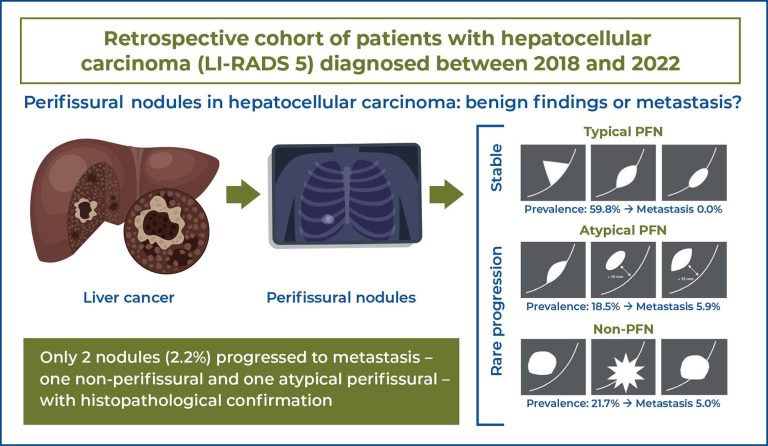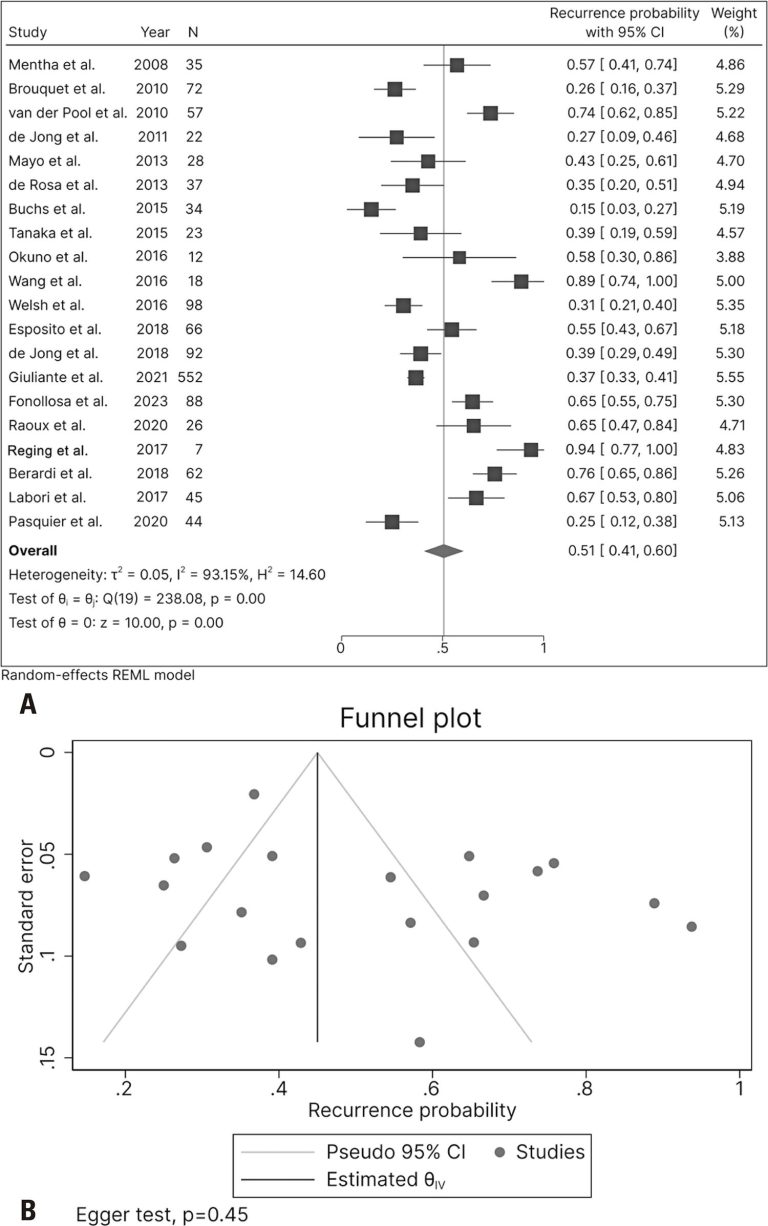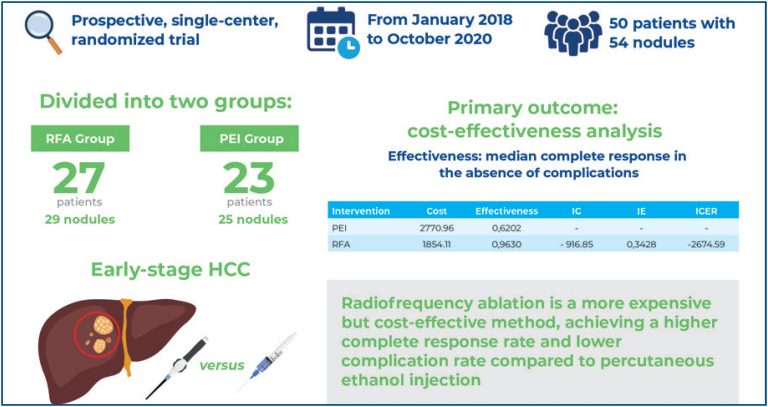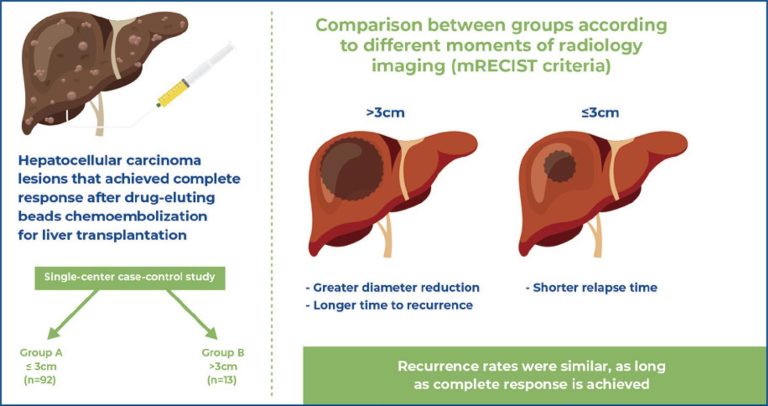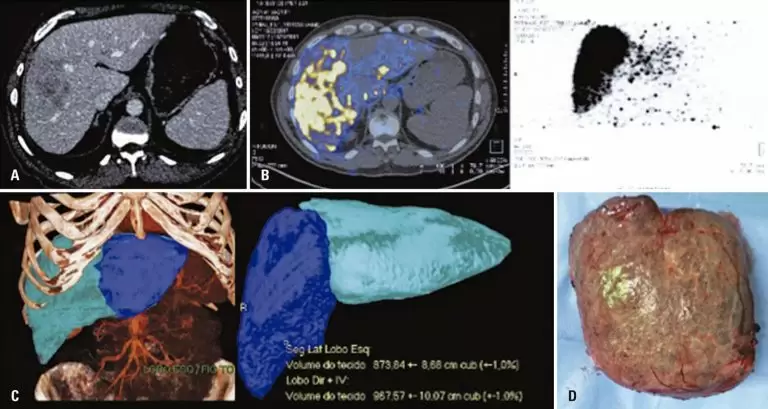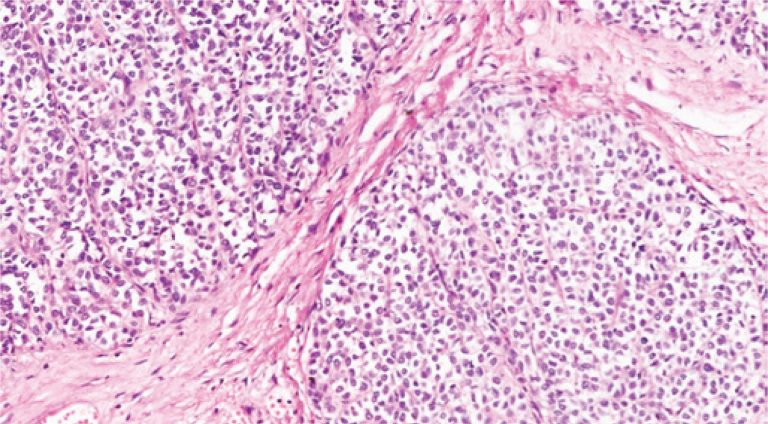25/Nov/2025
Pulmonary nodules near fissures in hepatocellular carcinoma: assessing their clinical significance
DOI: 10.31744/einstein_journal/2025AO1895
Highlights ■ Typical perifissural nodules remain radiologically stable with no metastatic potential. ■ Only two nodules progressed to metastasis (one atypical perifissural nodule and one non-perifissural nodule). ■ Atypical and non-perifissural nodules require closer follow-up. ■ Annual growth rate was a strong marker of malignancy. ABSTRACT Objective: To evaluate whether pulmonary nodules adjacent to fissures, particularly perifissural nodules detected on chest computed tomography in patients with hepatocellular carcinoma, can be reliably classified as benign based on their radiological characteristics. Methods: […]
Keywords: Carcinoma, hepatocellular; Diagnostic imaging; Liver neoplasms; Multiple pulmonary nodules; Neoplasm metastasis
Comparing radiological response to radiofrequency ablation, percutaneous ethanol injection, and transarterial chemoembolization in patients with hepatocellular carcinoma on the waiting list for liver transplant
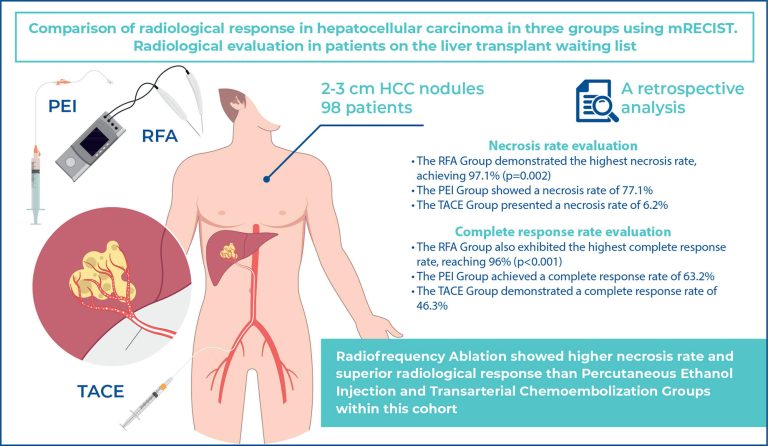
10/Nov/2025
Comparing radiological response to radiofrequency ablation, percutaneous ethanol injection, and transarterial chemoembolization in patients with hepatocellular carcinoma on the waiting list for liver transplant
einstein (São Paulo). 10/Nov/2025;23:eAO1315.
View Article10/Nov/2025
Comparing radiological response to radiofrequency ablation, percutaneous ethanol injection, and transarterial chemoembolization in patients with hepatocellular carcinoma on the waiting list for liver transplant
DOI: 10.31744/einstein_journal/2025AO1315
Highlights ■ Minimally invasive neoadjuvants are usually recommended for patients on the transplant waiting list. ■ Radiofrequency ablation showed a higher necrosis rate and superior radiological response than did percutaneous ethanol injection and transarterial chemoembolization in this study cohort. ABSTRACT Objective: We aimed to compare the radiological response in small hepatocellular carcinomas treated with radiofrequency ablation, percutaneous ethanol injection, and transarterial chemoembolization using the modified Response Evaluation Criteria in Solid Tumor radiological evaluation in patients on the waiting list for […]
Keywords: Catheter ablation; Chemoembolization therapy; Ethanol; Hepatocellular carcinoma; Liver neoplasms; Liver transplantation; Radiofrequency ablation; Waiting lists
13/Nov/2024
Liver-first approach to the treatment of patients with synchronous colorectal liver metastases: a systematic review and meta-analysis
DOI: 10.31744/einstein_journal/2024RW0596
ABSTRACT Objective The optimal approach to the treatment of colorectal carcinoma and synchronous liver metastases remains controversial. The objective of this review was to analyze the outcomes of adopting the liver-first approach for the treatment of patients with colorectal cancer with synchronous hepatic metastases who initially underwent systemic chemotherapy and/or resection of the metastatic lesions and primary colorectal carcinoma. Methods This review was conducted in accordance with the Preferred Reporting Items for Systematic Reviews and Meta-Analyses guidelines. The MEDLINE, EMBASE, […]
Keywords: Colorectal neoplasms; Hepatectomy; Liver neoplasms; Liver surgery; Neoplasm metastasis
25/Sep/2024
Cost-effectiveness of radiofrequency ablation versus percutaneous ethanol injection for early hepatocellular carcinoma in a resource-poor setting: a randomized trial
einstein (São Paulo). 25/Sep/2024;22:eGS0683.
View Article25/Sep/2024
Cost-effectiveness of radiofrequency ablation versus percutaneous ethanol injection for early hepatocellular carcinoma in a resource-poor setting: a randomized trial
DOI: 10.31744/einstein_journal/2024GS0683
Highlights Radiofrequency ablation and percutaneous ethanol injection are neoadjuvant hepatocellular carcinoma treatment methods. Radiofrequency ablation achieves a higher complete response rate (96.3% versus 60.0%, p=0.001). Total cost analyses showed radiofrequency ablation as a more expensive method (p<0.001). The incremental cost-effectiveness ratio was US$ -2674.59 with an advantage for radiofrequency ablation. Incremental effectiveness (34.2%) was in favor of radiofrequency ablation versus percutaneous ethanol injection. ABSTRACT Objective: This study assessed the cost-effectiveness of radiofrequency ablation compared with percutaneous ethanol injection in patients […]
Keywords: Ablation techniques; Cost-effectiveness evaluation; Liver neoplasms; Liver transplantation; Radiology, Interventional
19/Oct/2023
Radiological characteristics of hepatocellular carcinoma that achieved complete response after chemoembolization with drug-eluting beads for liver transplantation planning
einstein (São Paulo). 19/Oct/2023;21:eAO0307.
View Article19/Oct/2023
Radiological characteristics of hepatocellular carcinoma that achieved complete response after chemoembolization with drug-eluting beads for liver transplantation planning
DOI: 10.31744/einstein_journal/2023AO0307
Highlights Once complete hepatocellular carcinoma necrosis is achieved, the diameter of the hepatocellular carcinoma decreases significantly, regardless of its initial size. Hepatocellular carcinoma >3cm showed greater reduction and longer time to recurrence. Hepatocellular carcinoma ≤3cm exhibited a shorter time to relapse. Recurrence rates were similar, as long as complete response was achieved. ABSTRACT Objective: To describe the radiological characteristics of hepatocellular carcinoma (HCC) lesions that achieved a complete response following drug-eluting bead transarterial chemoembolization (DEB-TACE) preceding liver transplantation. Methods: This […]
Keywords: Carcinoma, hepatocellular; Chemoembolization, therapeutic; Liver neoplasms; Living donors; Neoadjuvant therapy; Radiology, Interventional; Response evaluation criteria in solid tumors
19/Feb/2020
Transarterial radioembolization for liver tumors as neoadjuvant therapy: three case reports
DOI: 10.31744/einstein_journal/2020RC4990
ABSTRACT Transarterial radioembolization (TARE) with yttrium-90 microspheres is a palliative locoregional treatment, minimally invasive for liver tumors. The neoadjuvant aim of this treatment is still controversial, however, selected cases with lesions initially considered unresectable have been enframed as candidates for curative therapy after hepatic transarterial radioembolization. We report three cases in which the hepatic transarterial radioembolization was used as neoadjuvant therapy in an effective way, allowing posterior potentially curative therapies.
Keywords: Cholangiocarcinoma; Embolization, therapeutic/methods; Liver neoplasms; Neoadjuvant therapy; Radioembolization
18/Nov/2014
Primary hepatic carcinoid tumor: case report and literature review
DOI: 10.1590/S1679-45082014RC2745
Primary hepatic carcinoid tumors are extremely rare neoplasms derived from hormone-producing neuroendocrine cells. It is difficult to make their diagnosis before biopsy, surgical resection or necropsy. A recent publication described only 94 cases of these tumors. There is no sex predilection and apparently it has no association with cirrhosis or preexisting hepatic disease. The most effective treatment is hepatectomy, and resection is determined by size and location of the lesions.
Keywords: Carcinoid tumor; Case reports; Liver neoplasms; Neuroendocrine tumors/diagnosis


